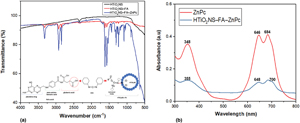Published online by Cambridge University Press: 14 November 2019

Glioblastoma (GBM) is one of the most aggressive types of cancer which currently does not have a cure. Its invasive nature and heterogeneity makes its complete surgical removal impossible. Hence, a targeted treatment is critically needed to effectively eradicate this cancer. In this work, the authors report the synthesis of hollow TiO2 nanospheres (HTiO2NS) and their functionalization with folic acid (FA) and zinc (II) tetranitrophthalocyanine (ZnPc) to achieve cell selectivity and light absorption in the visible range. In vitro cytotoxicity of the functionalized HTiO2NS against M059K cell line (Human GBM cancer cells) was tested. In vitro generation of reactive oxygen species by HTiO2NS–FA–ZnPc nanostructures under UV irradiation was detected by fluorescence probing. To identify HTiO2NS–FA–ZnPc cell localization, the nanoparticles were labeled with fluorescein isothiocyanate dye and visualized by fluorescence microscopy. Results illustrate that HTiO2NS–FA–ZnPc nanostructures have the potential to be used for targeted photodynamic therapy for the treatment of GBM cancer.
To send this article to your Kindle, first ensure no-reply@cambridge.org is added to your Approved Personal Document E-mail List under your Personal Document Settings on the Manage Your Content and Devices page of your Amazon account. Then enter the ‘name’ part of your Kindle email address below. Find out more about sending to your Kindle. Find out more about saving to your Kindle.
Note you can select to save to either the @free.kindle.com or @kindle.com variations. ‘@free.kindle.com’ emails are free but can only be saved to your device when it is connected to wi-fi. ‘@kindle.com’ emails can be delivered even when you are not connected to wi-fi, but note that service fees apply.
Find out more about the Kindle Personal Document Service.
To save this article to your Dropbox account, please select one or more formats and confirm that you agree to abide by our usage policies. If this is the first time you used this feature, you will be asked to authorise Cambridge Core to connect with your Dropbox account. Find out more about saving content to Dropbox.
To save this article to your Google Drive account, please select one or more formats and confirm that you agree to abide by our usage policies. If this is the first time you used this feature, you will be asked to authorise Cambridge Core to connect with your Google Drive account. Find out more about saving content to Google Drive.